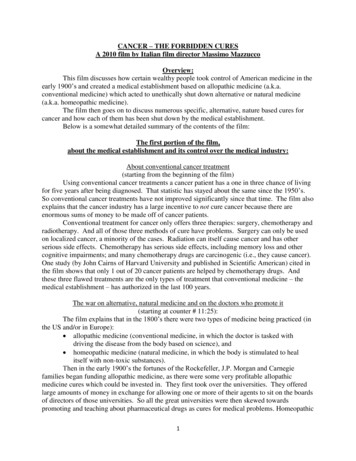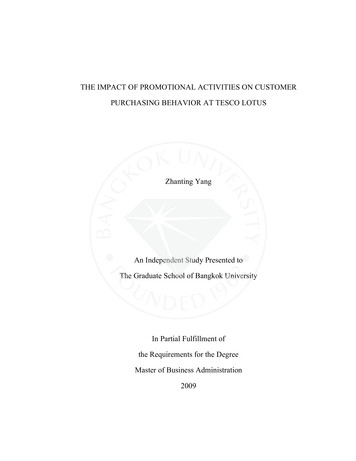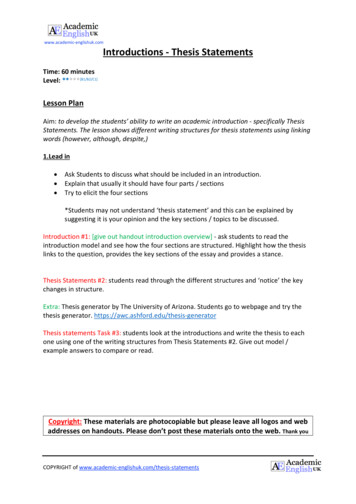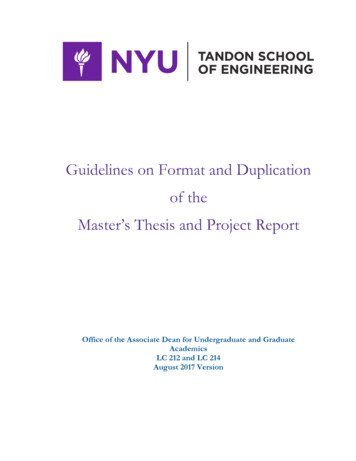
Transcription
V79NORTH TEXAS NOW:PRODUCTION OF APROMOTIONAL FILMTHESISPresented to the Graduate Council of theNorth Texas State University in Partialulfillment of the RequirementsFor the Degree ofMASTER OF ARTSByHenry David Kaplan, B. A.Denton, TexasAugust, 1974
Kaplan, Henry D., North Texas Now:PromotionalProduction of ailm, Master of Arts (Speech Communicationand Drama), August, 1974, film:16mm, 522 feet,minutes, color, sound; production book:14 i143 pp., biblio-graphy, appendix, 69 titles.To supplement student recruiting efforts,the Officeof Admissions and Records, North Texas State University(rSU),funded a color sound promotional film, North TexasNow (NTi), describing academic and nonacademic services andactivities of NTSU and its surrounding area.NTusesfast-paced montage and contemporary music, and for contrastand historic perspective, it opens and closes with sepiaphotographs depicting the early days of NTSU.An accompanying production book describes the makingof NTN, examines the background against which NT2 was proposed, describes problems and procedures of production,analyzes the film, and offers recommendations for otheruniversity fIlm productions,
TABLE OF CONTENTSPageI*.INTRODUCTION .*ChapterBackgroundProblemPurposePlan of the StudyPrevious and Related ResearchII.DEFINITIONS AND Dallas Motion Picture ServicesIII.PRE-PRODUCTION .*.a.ea.Establishing mingEditingV.A STRUCTURAL ANALYSIS OF NORTH TEXAS NOW ,.*The IntroductionRegistrationArts and SciencesTIe LibraryCommunity ServicesBusiness AdministrationEducationThe School of MusicSportsExtracurricular ActivitiesEnd CreditsVI.CONCLUSIONS AND RECOMMENDATIONS. .ConclusionsRecommendationsilla.
APPENDIX, . . . . . . . . . . . . . . . . . .BTBLIOGRAPHY. . . . . . . . .iv,* .,. .*. * *#. . .92. . 139
CHAPTER IINTRODUCTIONBackgroundAs a result of a change in the mandatory SelectiveService requirements, a tighter money economy, and arealization by young people that higher education is notessential for getting jobs, enrollments at institutionsof higher learning have,in some cases, decreased and, inothers, have not increased as much as desired.For collegesand universities that rely on student enrollment for funding,Funding is tied to enrollment toa potential crisis exists.some degree at nearly every institution.Certainly privatecolleges get a large part of their money from tuition.Yet many public colleges and universities also depend uponenrollment for funding.Legislative appropriations fortax-supported, public colleges and universities are often2proportional to enrollment.Loss of revenue by an educational institution can leadto serious consequences.result.Faculty and staff cutbacks couldBuilding programs could be suspended.budgets could be reduced.OperatingTo stay financially solvent,3tuition rates would have to rise faster than faculty salaries.And, as tuition costs climb, fewer young people can afford to1
2attend college.Naturally, since funding is so closely tiedto enrollment, colleges and universities wish to stop decliningenrollments.In the past, colleges and universities have relied onthe personal contact activities of recruiters to solicit newstudents.Often working for offices of admissions at collegesand universities, "student recruiters" visit high schools hopingto interest seniors in enrolling at the schools represented bythe recruiters.Traditional recruiting techniques, "low key"in nature, are little more than face-to-face meetings withstudents, supported by written literature describing thecollege or university.Now, however, nontraditional means of student recruitingare being used.Institutions of higher learning are exploringsuccessful commercial recruiting methods.These colleges anduniversities utilize radio and television commercials, billboards, and other "high key" approaches.One nontraditionalapproach to recruiting is the use of a promotional film tosupplement the face-to-face interview or small group counseling session.Some colleges and universities have adoptedthe film techniques of corporate and military recruiters tosupplement student recruitment.5North Texas State University is one institution thathas recently found need to supplement its student recruitingactivies with a promotional film.North Texas State Univer-sity expected a five percent decline in enrollment for the
3fall, 1973, semester.The actual loss of enrollment turnedout to be just a little over one percent.However, accordingto Marcella Rogers, Assistant Director of Admissions, thiswas the first enrollment decrease since 1953.6Even thissmall loss could have conceivably resulted in a loss of funds.Additionally, this loss of enrollment could be indicative ofa trend.If North Texas State University were to lose studentsand, thus financial support, it would be forced to decrease itsservices.Therefore, at North Texas State University as atmany other educational institutions, it was felt imperativeto stop the decrease in enrollment and, if possible, to evenincrease enrollment.Key personnel within the Office of Admissions and Recordsat North Texas State University proposed that a film be made7and included in student recruiting activities.Dr. DouglasNorton, Dean of Admissions and Records, viewed a film madefor Southern Methodist University.After seeing the film,Norton encouraged the idea of a promotional film for NorthTexas State University.He felt that the film could act asan "attention getter" to make high school students aware ofNorth Texas State University.8ProblemCommercial production companies make films "on order"for charges that start at 1000 per screen minute.9Unfor-tunately, funds for a promotional film at North Texas State
University were scarce.Contracting a commercial film pro-duction company then was not feasible.Therefore, theOffice of Admissions and Records decided to utilize universityresources.The Division of Radio-Television-Film in the De-andpartment of Speech Communication and Drama was contactedasked if the division could provide the facilities and thepersonnel to make the film.Professor Paul E. Potter,instructor in the division, agreed to accept responsibilityfor initiating the project and to act as faculty liaison untilthe film was completed.PurposeThe purpose of this thesis was the production of a sixteen millimeter color sound motion picture as requested bythe Office of Admissions and Records at North Texas StateUniversity.The film is titled North Texas Now (NTN).The accompanying production book describes the mannerby which a film of professional calibre was produced withinan academic community by utilizing university resources (students, faculty, staff, equipment, facilities, etc.).Further,the production book describes and identifies the major problems facing the production of NTN,and how these problemswere solved.Plan of the StudyIn order to explain the making of NTN, the productionbook outlines the production sequences followed to create
5the film.Although these sequences consisted of three parts,and production.they are presented as two parts--pre-productionThe third part of the production sequence, post production, isnot discussed in this production book since post production washandled by a commercial laboratory and not the filmmaker.Additionally, the production book defines goals and limitationsof the film production process as they were understood at thetime of filming.A list of definitions explains terminologyas specifically applied to the production of NTN.An internalshotsanalysis of the film rationalizes placement of specificin the film. This analysis also describes the function ofeach shot as it relates to other shots.A summary lists thegeneral lessons learned during production of NTN.The production book is arranged in the following sequenceof chapters:I.II.III.IV.V.VI.IntroductionDefinitions and ProceduresPre-ProductionProductionA Structural Analysis of North Texas NowConclusions and RecommendationsFurther, an appendix contains various documents associatedwith production of the film--the script, the names of the production crew, the budget, etc.This production book utilizesthe MA Style Sheet, Second Edition and will place footnotesat the conclusion of each chapter.
6Previous and Related ResearchThe literature of film is extensive.DissertationAbstracts International Index lists twenty-one dissertationsand oneon the subject of film written between 1969 and 1970.10dissertation that studies film as a persuasive medium.On the masters level, thesis requirements have beensatisfied with film.At the University of Texas in Austin,films are accepted in fulfillment of the thesis requirementsfor the masters degree. 1 1the film S.M.U. TodQAt Southern Methodist Universityhad the dual function of graduatethesis and promotional film.Although film has never been submitted at North TexasState University as a thesis, creative theses have been submitted and accepted in partial fulfillment of the requirementsfor the masters degree.Many creative theses have been com-pleted in the fields of art and drama.Like other creativetheses the film North Texas Now is a completely original work.
NOTESPinch for Colleges," U.S. News and10 May 1971, p. 28.1 "Moneyorld Repofrt,legislatures under pressure from taxpayers arecutting back appropriations, and funds are lost when stateandlegislatures lower the legal age to 18, since collegestuitions,universities are then deprived of higher out-of-state"Money Pinch," U. S.fIe w, 28. "Legal Maturity at 18 Has ItsSide Effects," Business Week, 5 February 1972, p. 102.2 Also,3 "MoneyPinch," fU. News,4 "Recruitment Rock," Time,p. 28.29 October 1973, p. 102.military and corporate personnel firms have usedfilm for some time. The Army has been appropriated ten million dollars to encourage enlistments by use of advertisingwill beand public relations efforts. Many of these effortsYork:(NewAdvertisingCohn,filmed productions. DorothyFilm is usedJohn and Sons, Inc., 1972), pp. 626 and 674.to job interinterestbecause it is portable, it adds visualtheirexpecttoviews, and the public has been conditionedRomneyinformation to be packaged in audio visual formsWheeler, "The Changing Face of Public Relations," BusinessScreen, (November-December 1972), p. 48. Southern MethodistUniversity, Dallas, Texas, and the Dallas County JuniorCollege, Dallas, Texas, are two schools that use film forstudent recruiting. North Texas State University has a film,The 2 ory of North Texas. The film is black and white and wasproduced by the United Students of North Texas in 1963. Howthis film was used or whether it was used for recruiting isunknown.5 Bothwith Marcella Rogers, Assistant Director ofTexas State University, Denton, Texas,NorthAdmissions,North Texas DAily, 4 September 1973.15 November 1973.6 Interview7 Marcella8 TheRogers.North Texas Daily, 16 November 1973.with Lloyd Abernathy, Vice-President,Motion Picture Laboratory of Dallas, Inc., Dallas, Texas,11 August 1973.9 Interview7
8Retrospectiverb r erox university Microfilm, 1975Y710Dssertation Abstract International,Index,'11?inpr. 55, I1, 1003, 1056-1057.interview with Betty Nunley, secretary,School of Communications, University of Texas, Austin,Texas, 31 October 1973.1 1 Telephonedated 19 October 1973, James B. McGrath,Chairman, Department of Communication Arts, SouthernMethodist University, Dallas, Texas.1 2 Letter
CHAPTER IIDEFINITIONS AND PROCEDURESThis chapter is a detailed outline of the filmmaking process.The chapter contains two sections, terminology and procedures.In the first section terminology necessary to understand thefilm production process is discussed.These terms are arrangedin the order in which they occur during production.These termsare grouped into four broad classifications--general terminology,pre-production terminology, production terminology, and postproduction terminology.In the second section of the chapter,NTN filmmaking procedures are outlined.Dallas commercial pro-duction services are also discussed.TerminologyGeneral TerminologyThe "filmmaker" (as used in this production book) is theindividual in charge of producing, directing, scripting,editing, and budgeting a film.The term filmmaker refersto an independent film producer who operates outside therealm of established film production companies.The filmmakerusually produces films with a minimum production crew and atlow budget levels.The term "filmmaker" as used here shouldnot be confused with the term "flimmaker" as applied to anyonemaking avantmde,"art" type, or serious "Hollywood" productions.9
10A "promotional film" is a film that seeks to establishan idea or image of an organization or institution.tional film, NTN has three functions.As a promo-First, NTN tried tobring attention of the intended audience--high school studentsand the general community--to the academic life at North TexasSecond, NTN tried to create an image thatState University.would interest and excite prospective students and their parents.Third, NTN attempted to increase the effectiveness of face toface contacts between North Texas student recruiters and thestudents they met.A promotional film is only one of manytools used within a promotional, recruiting, or public relations effort. 1Pre-production TerminologyA "script" is the written guide or blueprint from whicha film is made.duce NTN.There were four types of scripts used to pro-First, the "idea script" was a short statementdescribing the intention of the film.Second, the "researchscript" was an unorganized compilation of facts, data, literature, and interviews.The research script was used to helpconstruct the structure and content of NTN.Additionally,the research script was used to insure accuracy in the narration.Third, the "shooting script" was a detailed andorganized outline of the content and structure of the film.The shooting script indicated the subjects to be filmed, thetime devoted to each subject, and the order in which the
11subjects would be presented in the finished film.The shootingscript contained audio as well as visual guidelines that described shots, scenes, and sequences.Fourth, a "breakdownscript" was a script that had reordered all the visual information contained in the shooting script and was used for theconvenience of the cameramen.The reordering was done so thatfilming could be accomplished in the most efficient and leastcostly way possible.Efficiency was achieved by schedulingtogether all shots of similar locale, setting, and subjectIn addition to scripts, "cue sheets" were necessarymatter.to produce NN.Cue sheets are rather specific guides thathelp develop certain portions of the shooting script by defining each shot more specifically in relation to the othershots.Cue sheets contain time, length, and placement2information for music, narration, and animation work.Withinscripts and cue sheets, film structure is described in termsof scenes, shots, and sequences.A "shot" is all the footagetaken by one camera running without interruption.It is thelength of film defined by the cut, dissolve, fade, or otheroptical deviceas the shot appears when projected.3A"scene" is a unified action occurring at a single time andplace.It may consist of a single shot but usually is a groupof shots.in the production of NTN the terms "shot" and"scene" are used interchangeably.A "sequence" is a groupof shots or scenes that comprise an entire segment of thefilm.The segment is the smallest portion of the film that
12still tells a visual story.5In the production of NTN"sequence" referred to a series of shots that correspondedto a definite subject covered in the film.Production Terminologx"Sixteen millimeter" (16mm) was the size of the filmused to produce NTN.The sixteen millimeter refers to thewidth of the film.6"Raw stock" or "film stock" is unexposed film.film that is ready to be shot.It isThe three 16mm film stocksused in NTN were Ektacrhome EF tungsten 7242 (EFB), Ektachrome EF Daylight 7241 (EFD), and Ektacrhome Commercial7252 (E 0)."Camera original footage," also called "camera original"or "original," is processed film that has been shot, i.e.exposedin the camera.all copies are made.This film is the master from whichWhile the film itself is inexpensive,the images captured on it cost time and money.original is valued, protected, and cared for.Hence, cameraIt is usuallyhandled with white gloves and is kept in a vault when notneeded.The terms "A wind" and "B wind" are used to indicate theposition of emulsion on film stock relative to the spool onwhich it is wound.is B wind.When film is wound emulsion-in, the filmWhen the film is wound emulsion-out, it is A wind.Camera original footage is B wind whereas projection film is
13A wind.7A wind and B wind should not be confused with A-Brolling described below."Negative-Positive" filming is a process of film productionthat uses negative film stock.On negative film stock the tonesand the colors of a scene are both reversed,A negative filmmust be printed onto positive stock before it can be projected.8By contrast, "reversal filming" is a process of film productionthat uses reveral film stock.Reversal film stock reproducesthe tones and colors of a scene as they appear in nature.Areversal filr can be projected after it is shot and processed.Motion picture "composition" is generally considered to bethe arrangement of the visual elements within the two dimensionalsurface of motion picture film.Composition in motion picturesis never static as is composition in still photography.Motionpicture composition is the arrangement of elements from frameto frame as well as the arrangement of elements within a frame.Specific identification of the elements of motion picturecomposition varies from source to source.Within the NTN pro-duction three elements of composition were identified--continuity,movement, and framing.Continuity is so basic and important tomotion picture composition that it will be defined separatelybelow.Movement as an element of motion picture compositioncan be classified as either subject movement within a frame,frame movement itself, or movement of subject and/or frame fromshot to shot.Movement occurs through time, space,or both.Framing is the way elements within the two dimensional format
14are enclosed by the sides of the film frame.Composition iNTNwas concerned mainly with framing and not with movement or continuity.Framing inNTN was defined by three terms,"close-up," or "extreme close-up,""long shot,"A long shot is a compositionshowing large expanses of physical area in a scene.Any shotshowing an area that can be filled by more than five people isa long shot@shots.A shot tightly encompassing two to five people is amedium shot.person.This designation also includes aerial and scenicThe close-up is a portrait composition of oneAn extreme close-up is a shot in which only a portionof a person's face is visible or a shot in which a small objectis shown.The third element of motion picture composition,"contin-uity," is the unifying relationship between all segments of afilm that gives the film a feeling of wholeness and connectedness.Continuity is a function of film structure and film content.Continuity can be created in shooting and in editing and is visualas well as aural.In the shooting stage of film production,continuity in film structure is created by selecting shots thatlogically follow the action of the subject.9Content contin-uity is developed during shooting by emphasizing visualrelationships.In the editing stage, film structure is givencontinuity by matching color, movement, subject size, and direction of movement from one shot to that of the preceeding andsucceeding shots.10Content continuity is created in editingby arranging both visual and aural elements.Continuity in the
15content and structure of NTN was created by a greater relianceon the aural element musi
University, Dallas, Texas, and the Dallas County Junior College, Dallas, Texas, are two schools that use film for student recruiting. North Texas State University has a film, The 2 ory of North Texas. The film is black and white and was produced by the United Students of North Texas in 1963. HowAuthor: Henry David Kaplan











